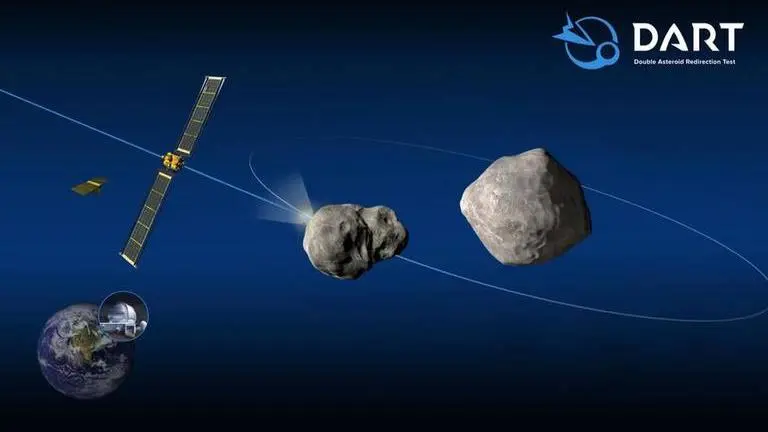Updated 25 October 2021 at 07:06 IST
NASA's DART Mission to shoot rocket into asteroid; Here's all you need to know
NASA is preparing for the launch of its DART mission, which will evaluate methods of averting a potentially hazardous asteroid from colliding with Earth.
- Science News
- 3 min read

The National Aeronautics and Space Administration (NASA) is preparing for the launch of the Double Asteroid Redirection Test (DART) mission, which will evaluate methods of averting a potentially hazardous asteroid from colliding with Earth. The DART mission is scheduled to launch on a SpaceX Falcon 9 rocket from Vandenberg Space Force Base in California at 10:20 pm PST on November 23, 2021 (1:20 am EST on November 24). The launch will be broadcast live on NASA TV, the NASA app, and the agency's website.
DART mission will be the first test of the kinetic impactor technique, which entails delivering one or more huge, high-speed spacecraft into an asteroid's path in space to alter its trajectory. The binary near-Earth asteroid Didymos and its moonlet are its targets. DART is a planetary defense-driven test of technologies aimed at preventing an asteroid from colliding with Earth. DART will be the first time a kinetic impactor will be used to alter an asteroid's velocity in space.
We're crashing a spacecraft into an asteroid… on purpose! Our #DARTmission is a #PlanetaryDefense test to change the motion of an asteroid in space, so we could use this technique if an Earth-threatening asteroid were found. Watch Behind the Spacecraft: https://t.co/c3NqOhHcIr pic.twitter.com/Uw5hVk54uP
— NASA (@NASA) October 24, 2021
The DART demonstration will focus on the binary near-Earth asteroid (65803) Didymos. While the core body of Didymos is around 780 metres in diameter, its secondary body (or "moonlet") is roughly 160 metres in diameter, which is more typical of asteroids that potentially pose the greatest threat to Earth. Before DART arrives, the Didymos binary is being closely monitored using Earth-based telescopes in order to precisely measure its features.
DART spacecraft will purposefully smash into moonlet
With the use of an onboard camera called Didymos Reconnaissance and Asteroid Camera for OpNav (DRACO) and advanced autonomous navigation algorithms, the DART spacecraft will achieve the kinetic impact deflection by purposefully smashing into the moonlet at a speed of roughly 6.6 km/s. The impact will modify the speed of the moonlet in its orbit around the parent body by a fraction of a per cent, but it will also change the moonlet's orbital period by several minutes, which may be viewed and recorded using telescopes on Earth.
Advertisement
DART will use Roll Out Solar Arrays (ROSA) to supply solar power for its electric propulsion system once it is launched. As part of its in-space propulsion, the DART spacecraft will test NASA's Evolutionary Xenon Thruster – Commercial (NEXT-C) solar electric propulsion system. The NEXT-C system was developed at NASA's Glenn Research Center in Cleveland, Ohio, and is based on the Dawn spacecraft propulsion system. DART might benefit from tremendous mission timeline flexibility by using electric propulsion while proving the next generation of ion engine technology, which could be applied to future NASA missions.
(Image: NASA)
Published By : Aparna Shandilya
Published On: 25 October 2021 at 07:06 IST
